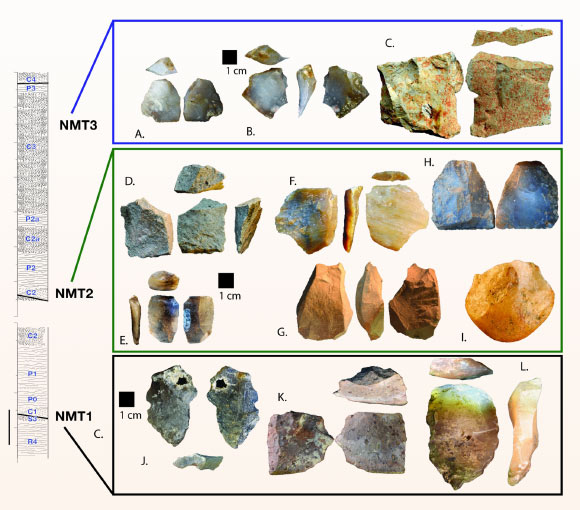Archaeologists have discovered Oldowan stone tools from three different archaeological horizons spanning approximately 300,000 years (2.75 to 2.44 million years ago) at the Namorotukunan site, part of the Koobi Fora Formation in the northeastern Turkana Basin in Kenya's Marsabit region. This discovery suggests continuity in tool-making practices over time and suggests a systematic selection of rock types.
A 2.58-million-year-old stone tool found at the Namorotukunan site in Kenya. Image credit: Brown etc.., doi: 10.1038/s41467-025-64244-x.
The earliest stages of tool production, beginning over 3 million years ago, highlight percussion technology, which is ubiquitous in hominin records and used by other primates.
Tool use associated with foraging is a recurring feature of some living primates.
The oldest systematic production of sharp-edged stone artifacts, known as Oldowan, is found in behavioral records of hominins at East African sites: Ledi Geraru and Gona in the Afar Basin (2.6 million years ago), Ethiopia and Nyayanga in western Kenya (2.6-2.9 million years ago).
Professor David R. Brown, an anthropologist at George Washington University and the Max Planck Institute for Evolutionary Anthropology, and his colleagues discovered numerous stone tool assemblages from three horizons at the Namorotukunan site, estimated to be 2.75, 2.58, and 2.44 million years ago.
“This site reveals an extraordinary story of cultural continuity,” Professor Brown said.
“What we are seeing is not a one-time innovation, but a long-standing technological tradition.”
“Our results suggest that tool use may have been a more widespread adaptation among our primate ancestors,” said Dr. Susana Carvalho, scientific director of Gorongosa National Park in Mozambique.
“Namorutukunan offers a rare glimpse into a long-gone changing world—rivers in motion, fires raging, aridity approaching—and tools that endure.”

Stone tools recovered from three horizons at the Namorotukunan site in Kenya. Image credit: Brown etc.., doi: 10.1038/s41467-025-64244-x.
“For 300,000 years, the same craft has persisted – perhaps revealing the roots of one of our oldest habits: using technology to protect ourselves from change,” said Dr. Dan V. Palcu Rolier, a researcher at GeoEcoMar, Utrecht University and the University of São Paulo.
“Early hominins created sharp-edged stone tools with extraordinary stability, demonstrating advanced skills and knowledge passed down from generation to generation.”
Using dating of volcanic ash, magnetic signals frozen in ancient sediments, chemical signatures of rocks and microscopic plant remains, researchers have pieced together an epic climate saga that provides context for understanding the role of technology in human evolution.
These instrument makers have experienced radical environmental upheaval. Their adaptable technology helped usher in new diets, including meat-based ones, turning challenges into survival advantages.
“These findings show that by about 2.75 million years ago, hominins were already making sharp stone tools, hinting that Oldowan technology originated earlier than we thought,” said Dr. Nigus Baraki, a researcher at George Washington University.
“At Namorotukunan, incisions link stone tools to meat-eating, indicating an expanded diet that persisted across changing landscapes,” added Dr. Frances Forrest, a researcher at Fairfield University.
“The plant fossil record tells an incredible story: the landscape changed from lush wetlands to dry, fire-ravaged grasslands and semi-deserts,” said Dr. Rahab N. Kinanjui, a researcher at the National Museums of Kenya and the Max Planck Institute for Geoanthropology.
“As the vegetation changed, tool production remained stable. That's sustainability.”
results appear in the magazine today Natural communications.
_____
Dr. Brown etc.. 2025. Early Oldowan technology flourished during Pliocene environmental changes in the Turkana Basin, Kenya. Nat Commun 16, 9401; doi: 10.1038/s41467-025-64244-x







